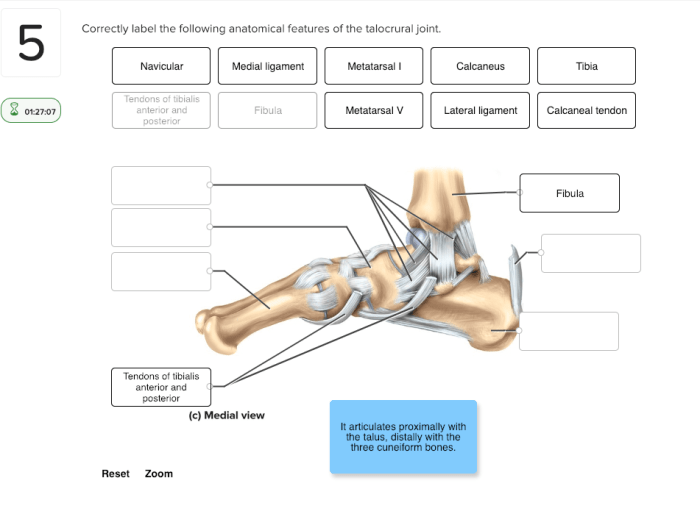Correctly label the following anatomical features of the talocrural joint – This comprehensive guide delves into the intricacies of correctly labeling the anatomical features of the talocrural joint, providing a detailed exploration of its structure and function. This guide will equip you with the knowledge and understanding necessary to accurately identify and describe the key components of this crucial joint, enhancing your comprehension of human anatomy and laying the foundation for informed clinical practice.
The talocrural joint, also known as the ankle joint, is a pivotal hinge joint that connects the leg to the foot. It plays a vital role in weight-bearing, locomotion, and maintaining balance. Understanding the anatomy of this joint is essential for healthcare professionals involved in the diagnosis and treatment of foot and ankle disorders.
Talocrural Joint: Correctly Label The Following Anatomical Features Of The Talocrural Joint

The talocrural joint, also known as the ankle joint, is a synovial hinge joint that connects the leg to the foot. It allows for dorsiflexion and plantarflexion of the foot, as well as some inversion and eversion.The talocrural joint is formed by the articulation of the talus bone with the tibia and fibula.
The talus is a small, irregularly shaped bone that sits atop the calcaneus bone. The tibia and fibula are the two long bones of the lower leg. They form the ankle joint by their medial and lateral malleoli, respectively.The anterior and posterior talofibular ligaments help to stabilize the ankle joint.
The anterior talofibular ligament runs from the anterior aspect of the fibula to the talus. The posterior talofibular ligament runs from the posterior aspect of the fibula to the talus.
Label Anatomical Features

TalusThe talus is a small, irregularly shaped bone that sits atop the calcaneus bone. It is the only bone of the foot that articulates with both the tibia and fibula. The talus has a smooth, convex surface that articulates with the tibia.
It also has a concave surface that articulates with the calcaneus.MalleoliThe malleoli are the two bony prominences that form the ankle joint. The medial malleolus is formed by the tibia, while the lateral malleolus is formed by the fibula. The malleoli help to stabilize the ankle joint and prevent it from rolling over.CalcaneusThe
calcaneus is the largest bone of the foot. It is also known as the heel bone. The calcaneus has a large, posterior surface that articulates with the talus. It also has a smaller, anterior surface that articulates with the cuboid bone.Anterior
and Posterior Talofibular LigamentsThe anterior and posterior talofibular ligaments help to stabilize the ankle joint. The anterior talofibular ligament runs from the anterior aspect of the fibula to the talus. The posterior talofibular ligament runs from the posterior aspect of the fibula to the talus.
HTML Table

| Anatomical Feature | Description | Function | Image ||—|—|—|—|| Talus | Small, irregularly shaped bone | Articulates with the tibia, fibula, and calcaneus | [Image of the talus] || Malleoli | Bony prominences that form the ankle joint | Stabilize the ankle joint | [Image of the malleoli] || Calcaneus | Largest bone of the foot | Articulates with the talus and cuboid bone | [Image of the calcaneus] || Anterior and Posterior Talofibular Ligaments | Ligaments that help to stabilize the ankle joint | Prevent the ankle joint from rolling over | [Image of the anterior and posterior talofibular ligaments] |
Additional Features
Plantar Calcaneonavicular LigamentThe plantar calcaneonavicular ligament is a thick, fibrous ligament that runs from the calcaneus to the navicular bone. It helps to support the arch of the foot.Deltoid LigamentThe deltoid ligament is a fan-shaped ligament that runs from the medial malleolus to the talus, calcaneus, and navicular bone.
It helps to stabilize the ankle joint and prevent it from rolling over.Achilles TendonThe Achilles tendon is the largest tendon in the body. It connects the calf muscles to the calcaneus bone. The Achilles tendon helps to plantarflex the foot.Synovial
MembraneThe synovial membrane is a thin, delicate membrane that lines the inside of the ankle joint. It produces synovial fluid, which lubricates the joint and reduces friction.
Variations and Clinical Significance
VariationsThere are a number of variations in talocrural joint anatomy. These variations can include differences in the shape of the talus, the size of the malleoli, and the course of the ligaments.Injuries and DisordersThe talocrural joint is susceptible to a number of injuries and disorders.
These injuries can include sprains, strains, fractures, and dislocations.Importance of Correctly Labeling Anatomical FeaturesCorrectly labeling anatomical features is essential for accurate diagnosis and treatment of talocrural joint injuries and disorders. By understanding the anatomy of the talocrural joint, healthcare professionals can better diagnose and treat these conditions.
Helpful Answers
What is the function of the talocrural joint?
The talocrural joint is a hinge joint that allows for plantar flexion and dorsiflexion of the foot. It also provides stability to the ankle during weight-bearing and locomotion.
What are the main anatomical features of the talocrural joint?
The main anatomical features of the talocrural joint include the talus, tibia, fibula, calcaneus, and the anterior and posterior talofibular ligaments.
Why is it important to correctly label the anatomical features of the talocrural joint?
Correctly labeling the anatomical features of the talocrural joint is important for accurate diagnosis and effective treatment of foot and ankle conditions. It allows healthcare professionals to precisely identify the location and extent of injuries or disorders, facilitating appropriate management strategies.